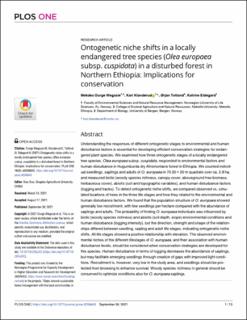| dc.description.abstract | Understanding the responses of different ontogenetic stages to environmental and human disturbance factors is essential for developing efficient conservation strategies for endangered plant species. We examined how three ontogenetic stages of a locally endangered tree species, Olea europaea subsp. cuspidata, responded to environmental factors and human disturbance in Hugumburda dry Afromontane forest in Ethiopia. We counted individual seedlings, saplings and adults of O. europaea in 70 20 × 20 m quadrats over ca. 2.8 ha, and measured biotic (woody species richness, canopy cover, aboveground tree biomass, herbaceous cover), abiotic (soil and topographic variables), and human disturbance factors (logging and tracks). To detect ontogenetic niche shifts, we compared observed vs. simulated locations of trees in the three life stages and how they related to the environmental and human disturbance factors. We found that the population structure of O. europaea showed generally low recruitment, with few seedlings per hectare compared with the abundance of saplings and adults. The probability of finding O. europaea individuals was influenced by biotic (woody species richness) and abiotic (soil depth, slope) environmental conditions and human disturbance (logging intensity), but the direction, strength and shape of the relationships differed between seedling, sapling and adult life stages, indicating ontogenetic niche shifts. All life stages showed a positive relationship with elevation. The observed environmental niches of the different lifestages of O. europaea, and their association with human disturbance levels, should be considered when conservation strategies are developed for this species. Human disturbance in terms of logging decreases the abundance of saplings, but may facilitate emerging seedlings through creation of gaps with improved light conditions. Recruitment is, however, very low in the study area, and seedlings should be protected from browsing to enhance survival. Woody species richness in general should be conserved to optimize conditions also for O. europaea saplings. | en_US |

